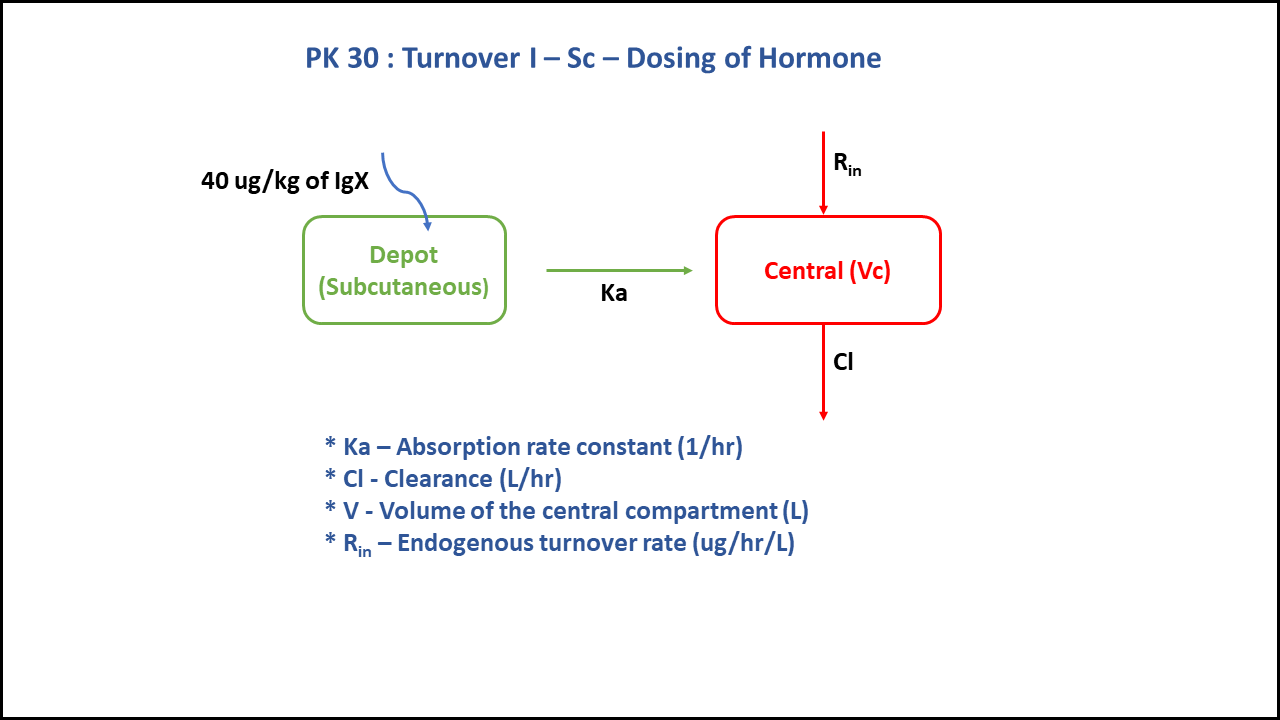using Random
using Pumas
using PumasUtilities
using CairoMakie
using AlgebraOfGraphics
using CSV
using DataFramesMeta
using Dates
PK30 - Turnover I - SC Dosing of Hormone
1 Background
- Structural model - One compartment first order elimination with zero order production of hormone
- Route of administration - Subcutaneous
- Dosage Regimen - 40 mcg/kg
- Number of Subjects - 1

2 Learning Outcome
With subcutaneous dose information, we learn to discriminate between the clearance and the rate of synthesis. Further simplification of the model is done by assuming bioavailability is 100% and concentration of the endogenous compound equals concentration at baseline (turnover/clearance)
3 Objectives
In this tutorial, you will learn how to build a one compartment PK turnover model, following first order elimination kinetics and zero order hormone production.
4 Libraries
Call the necessary libraries to get started
5 Model
In this two compartment model, we administer The dose subcutaneously.
pk_30 = @model begin
@metadata begin
desc = "Two Compartment Model"
timeu = u"hr"
end
@param begin
"""
Absorption rate constant (hr⁻¹)
"""
tvka ∈ RealDomain(lower = 0)
"""
Clearance (L/kg/hr)
"""
tvcl ∈ RealDomain(lower = 0)
"""
Turnover Rate (hr⁻¹)
"""
tvsynthesis ∈ RealDomain(lower = 0)
"""
Volume of Central Compartment (L/kg)
"""
tvv ∈ RealDomain(lower = 0)
Ω ∈ PDiagDomain(4)
"""
Additive RUV
"""
σ_add ∈ RealDomain(lower = 0)
end
@random begin
η ~ MvNormal(Ω)
end
@pre begin
Ka = tvka * exp(η[1])
Cl = tvcl * exp(η[2])
Synthesis = tvsynthesis * exp(η[3])
V = tvv * exp(η[4])
end
@init begin
Central = Synthesis / (Cl / V) # Concentration at Baseline = Turnover Rate (0.78) / Cl of hormone (0.028)
end
@dynamics begin
Depot' = -Ka * Depot
Central' = Ka * Depot + Synthesis - (Cl / V) * Central
end
@derived begin
cp = @. Central / V
"""
Observed Concentration (mcg/L)
"""
dv ~ @. Normal(cp, σ_add)
end
endPumasModel
Parameters: tvka, tvcl, tvsynthesis, tvv, Ω, σ_add
Random effects: η
Covariates:
Dynamical system variables: Depot, Central
Dynamical system type: Matrix exponential
Derived: cp, dv
Observed: cp, dv6 Parameters
The parameters are given below. Note that tv represents the typical value for parameters.
Ka- Absorption rate constant (hr⁻¹)Cl- Clearance (L/kg/hr)Synthesis- Turnover Rate (hr⁻¹)V- Volume of Central Compartment (L/kg)Ω- Between Subject Variabilityσ- Residual error
param = (
tvka = 0.539328,
tvcl = 0.0279888,
tvsynthesis = 0.781398,
tvv = 0.10244,
Ω = Diagonal([0.04, 0.04, 0.04, 0.04]),
σ_add = 3.97427,
)7 Dosage Regimen
A dose of 40 mcg/kg is given subcutaneously to a single subject.
ev1 = DosageRegimen(40, time = 0, cmt = 1)| Row | time | cmt | amt | evid | ii | addl | rate | duration | ss | route |
|---|---|---|---|---|---|---|---|---|---|---|
| Float64 | Int64 | Float64 | Int8 | Float64 | Int64 | Float64 | Float64 | Int8 | NCA.Route | |
| 1 | 0.0 | 1 | 40.0 | 1 | 0.0 | 0 | 0.0 | 0.0 | 0 | NullRoute |
sub1 = Subject(id = 1, events = ev1)Subject
ID: 1
Events: 18 Simulation
To simulate plasma concentration with turnover rate after oral administration.
Random.seed!(1234)The random effects are zero’ed out since we are simulating a single subject
zfx = zero_randeffs(pk_30, sub1, param)(η = [0.0, 0.0, 0.0, 0.0],)sim_sub1 = simobs(pk_30, sub1, param, zfx, obstimes = 0:0.1:72)SimulatedObservations
Simulated variables: cp, dv
Time: 0.0:0.1:72.09 Visualization
@chain DataFrame(sim_sub1) begin
dropmissing(:cp)
data(_) *
mapping(:time => "Time (hours)", :cp => "Concentration (μg/L)") *
visual(Lines; linewidth = 4)
draw(;
figure = (; fontsize = 22),
axis = (;
yscale = log10,
ytickformat = i -> (@. string(round(i; digits = 1))),
xticks = 0:10:80,
),
)
end10 Population simulation
par = (
tvka = 0.539328,
tvcl = 0.0279888,
tvsynthesis = 0.781398,
tvv = 0.10244,
Ω = Diagonal([0.0425, 0.0263, 0.0158, 0.0623]),
σ_add = 3.97427,
)
ev1 = DosageRegimen(40, time = 0, cmt = 1)
pop = map(i -> Subject(id = i, events = ev1), 1:50)
Random.seed!(1234)
pop_sim = simobs(pk_30, pop, par, obstimes = [0, 2, 3, 4, 5, 6, 8, 10, 15, 24, 32, 48, 72])
df_sim = DataFrame(pop_sim)
#CSV.write("pk_30.csv", df_sim)